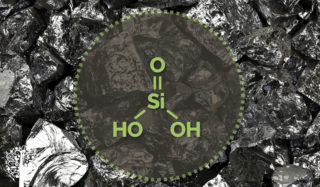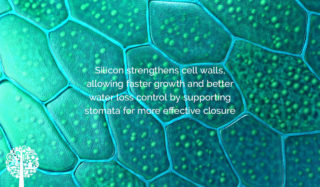Having been in the HVAC side of farming for many years, I have always hesitated to look into the side of the plant below the soil and what it takes for it to behave properly above the soil. However, now that environmental control is getting easier for me, I think it’s time to explore other parts of growing, and it’s turning out to be even more exciting and fun than I expected! I hope my explanations below do science justice, as the real-world results speak for themselves.
MSA Miracles
Some of you may have read my first article with Garden Culture about Hypochlorous Acid and how well it worked for me on Powdery Mildew (PM). In that application, we were foliar spraying our outdoor hemp, and the Hypochlorous did a great job preventing the spread of the PM while helping with bug prevention. However, the one thing I couldn’t achieve was stopping the PM from starting in my plants. A friend convinced me to specifically look at introducing mono-silicic acid (MSA) to my fertilizer mix. I had no idea what I was getting into, but six months later, I am astonished at the results and how well the product worked. None of my indoor plants has PM anymore, and neither does any of their clones. We have done one full round of flower from those plants, and we haven’t had to remove a single leaf due to PM. The indoor PM problem in my grow wasn’t horrible, but any amount is bad. This “experiment” was a huge success, and I was compelled to write about it.

The only change I made was the introduction of silicon in the form of mono-silicic acid to my reservoir. It seemed too easy; could this simple addition have made such a huge difference? However, the more I dug, the more it appeared true.
How It Works
After seeing such great results, I wanted to learn more about the product I was using and how it works. Silicon strengthens cell walls, allowing faster growth and better water loss control by supporting stomata for more effective closure. It increases root mass and, so indirectly, increases nutrient uptake. [1] All these systemic benefits increase leaf size, growth rate, Brix content and yield. But silicon’s role doesn’t stop there. Silicon deposed in or between cell walls (phytoliths, or ‘plant opals’) doesn’t just work as scaffolding; it provides direct protection against predation and fungal attack by forming a gel-like structure that physically repels penetration by mold spores and wears out the mouthparts of insect predators.

Silicates, Nano-Silicates, and Stabilised MSA
All silicon products are not equal. Silicates include industrial compounds like calcium, potassium silicate, and organic sources such as rice hulls. The downsides with silicates include the time needed for transformation by microorganisms into active mono-silicic. Think of silicates as a cow. We can not eat a cow, but we can eat a steak.
Then you have, Nano-silicates: As the name suggests, nano-silicates start as common raw materials and undergo proprietary processes to create and sometimes encapsulate tiny particles that can pass through tissue.
And finally, we have stabilized mono-silicic acid. Originally brought to the commercial agricultural market in the early 2000s, stabilized mono-silicic acid directly addresses the problem of the instability of naturally bioavailable silicon. The most straightforward explanation of how this process works is that specific amounts of Molybdenum and Boron are added to potassium silicate. Single atomic mono-silicic acids stick to the Molybdenum and Boron, making it available to plants. Manufacturers were able to provide immediately bioavailable silicon in the form that plants have evolved to use. The only downsides were high pricing, the inherent lack of an organic option, and the problem of breakdown above concentrations of around 4% mono-silicic acid. Still, given the tiny amounts required compared to traditional silicates and their increased effectiveness, they quickly took off in commercial agriculture. Since the mid-2000s, mono-silicic stabilization technology has moved forward again. Second-generation MSA uses ethanols for stabilization to achieve up to an incredible 40% mono-silicic acid concentration.
There is only one brand in the world using this new technology, Grow Genius. GG hasn’t publicly explained the magic of how they get to 40%, but I generally understand they use a different chemical process and ethanol to get a stable slow-release solution.
Happy Campers
We used 0.3ml/L of water in the reservoir for a week or so for our indoor crop. Each time we fill the tank, we add more mono-silicic acid at that ratio. We have never seen anything falling out, pH shifts in solution, or any mess from particulate residue. I’m excited to experiment with this product on our farm, Galiano Grow House Inc. We plan to use the product on all outdoor and indoor vegetables/fruits; the next step will be to start using the product in foliar applications. So, don’t be surprised when you hear from me again about the crop results.
Sources:
1) E. Epstein, “Silicon,” Annual Review of Plant Physiology and Plant Molecular Biology, vol. 50, pp. 641–664, 1999.
2) Liang Y.C., Sun W.C., Zhu Y.G., Christie P. Mechanisms of silicon-mediated alleviation of abiotic stresses in higher plants: A review. Environ. Pollut. 2007;147:422–428. doi: 10.1016/j.envpol.2006.06.008. [PubMed] [CrossRef] [Google Scholar] / Deshmukh R.K., Ma J.F., Bélanger R.R. Editorial: Role of silicon in plants. Front. Plant Sci. 2017;8:1858. doi: 10.3389/fpls.2017.01858. [PMC free article] [PubMed] [CrossRef] [Google Scholar] / Fauteux F., Rémus-Borel W., Menzies J.G., Bélanger R.R. Silicon and plant disease resistance against pathogenic fungi. FEMS Microbiol. Lett. 2005;249:1–6. doi: 10.1016/j.femsle.2005.06.034. [PubMed] [CrossRef] [Google